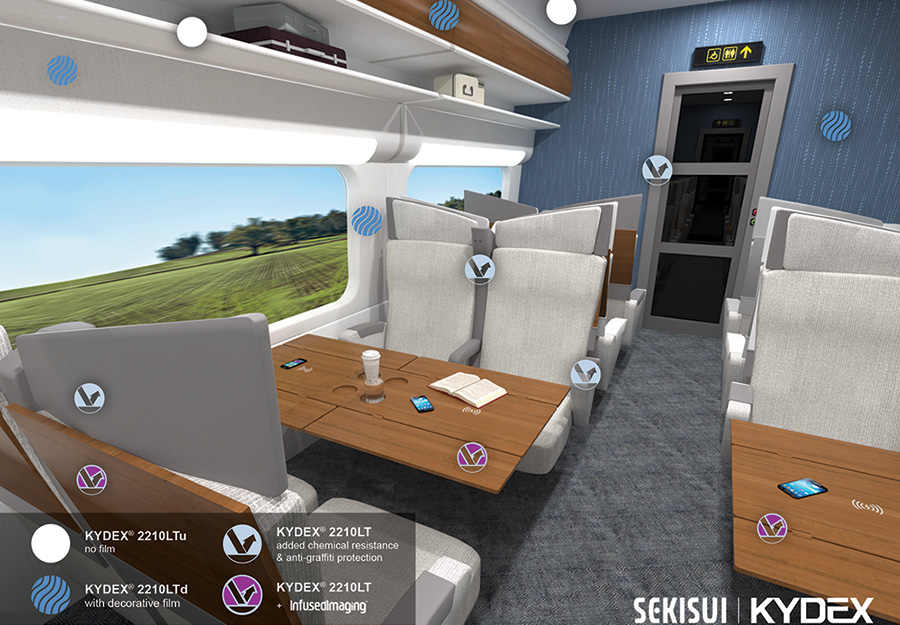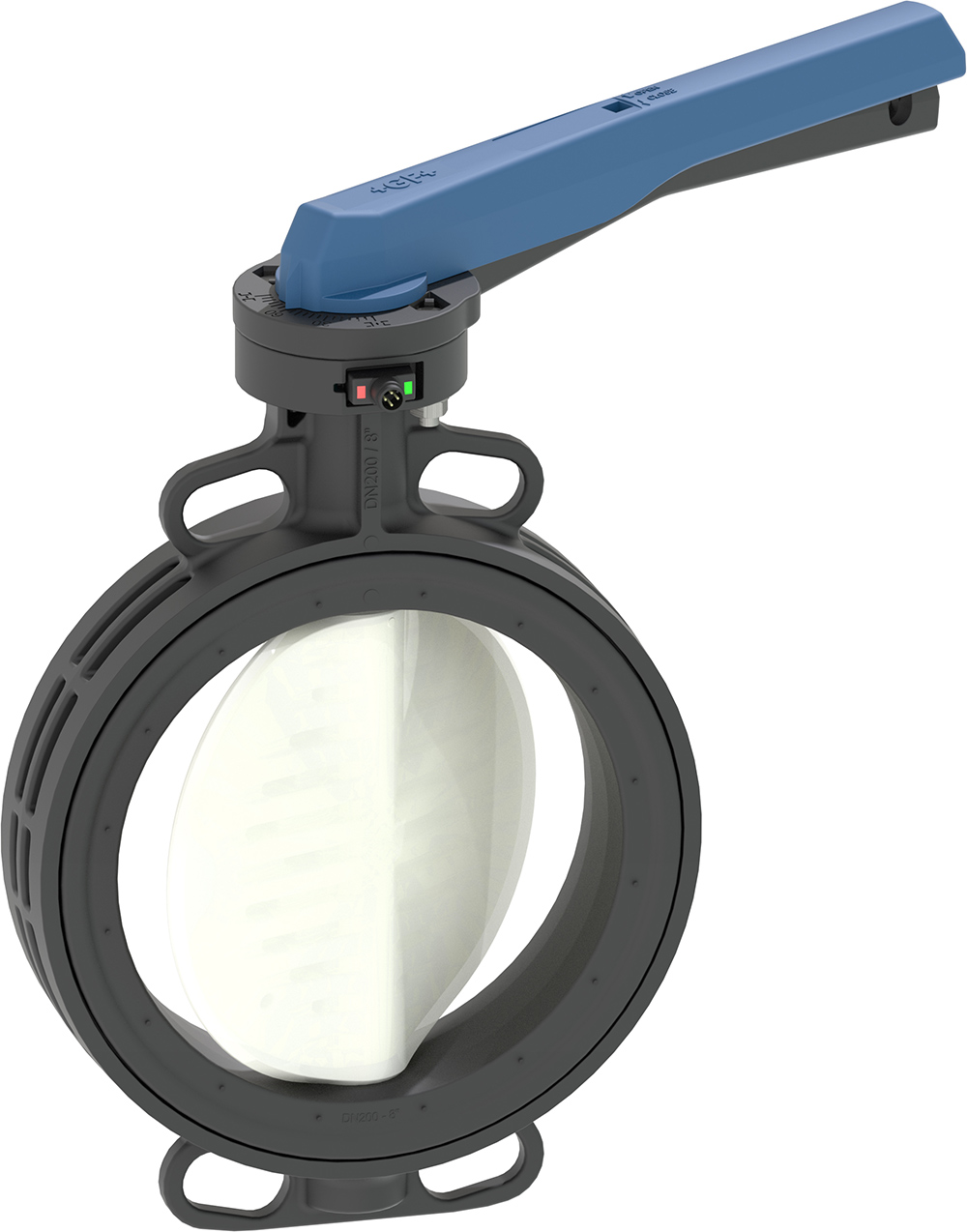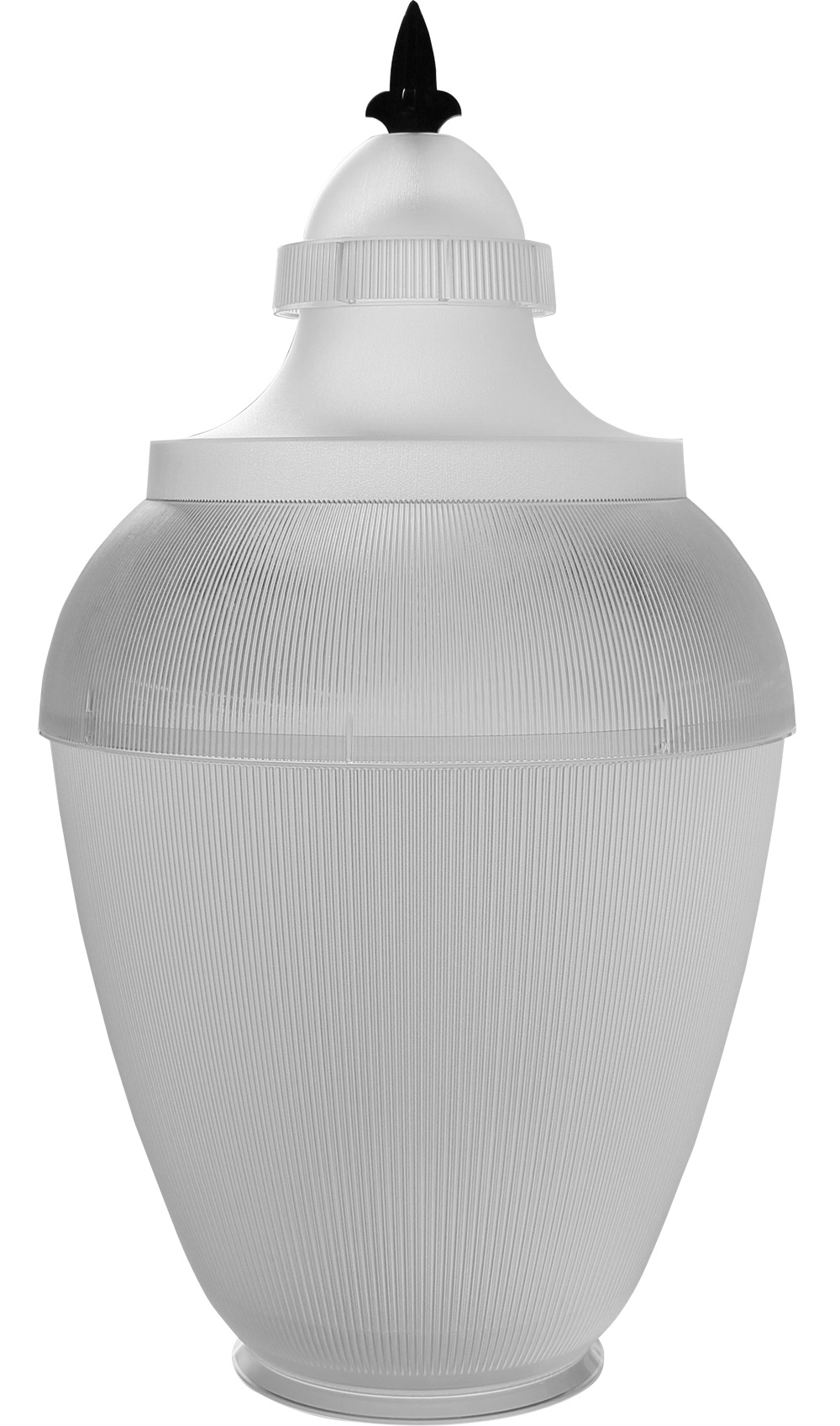
KYDEX® 2210LT from SEKISUI KYDEX
KYDEX 2210LT materials are suitable for rail car interior applications such as walls, passenger seat backs, armrests, tray tables and window masks or shrouds. Long-term durability and weight savings over FRP, aluminum or steel make KYDEX 2210LT a desirable and more sustainable choice for customers who expect rail cars to last 20 years or more. When the rail car reaches the end of its tracks, the KYDEX parts are 100 percent recyclable and ready to be made into something new.
KYDEX 2210LT materials provide design freedom to incorporate artwork and branding or prevent unsightly graffiti with its excellent graffiti resistance. “With the KYDEX 2210LT line, our rail interiors partners now have a fully compliant material that meets a complex set of regulations backed by the reliable quality and supply chain you expect from SEKISUI KYDEX,” said Ruben Bake, mass transit market business manager. “Using the entire product line, designers can create multi-faceted, layered designs with low minimums and custom color.”
This specialty sheet is produced using SEKISUI KYDEX’s quick response manufacturing (QRM) process, ensuring small minimum order quantities and short lead times. The materials-wide processing window and ease of thermoforming make them suitable for complex parts. In addition to availability in a wide range of integral custom colors and effects, no secondary processes are required to achieve desired aesthetics. www.kydex.com.

Available in sizes from NPS 2 through 12 (DN50-300), the 565 Valve is 60 percent lighter than a comparable metal valve, allowing a single technician to handle it safely and easily during installation. The lightweight material also minimizes the energy consumed for transportation and installation. After installation, the advantages of the reduced static weight may also be significant in life science and water treatment skids.
“GF’s Type 565 Butterfly Valve solves all of the typical problems customers experience with metal valves,” said Kevin Coduti, GF’s valve and actuation product manager. “With its higher corrosion resistance, longer service life and more effective use of energy and resources during industrial production, our new Swiss-made valve provides a more cost-effective and sustainable solution. These advantages, combined with its quick installation and simple retrofit capability, make it the valve of choice for water treatment and many other applications.”
The new valve comes in the same installation length as metal valves (ISO 5752 Row 20, API 609 Table 2) so that retrofitting requires no additional work on the pipes or new designs. This feature reduces time in planning and installation. The new release from GF Piping Systems is made from superior thermoplastics for a longer lifespan in water applications, making it almost maintenance-free. www.gfps.com./us.
- Biocompatibility
- Performance on par with metal
- Easy to process
- Light weight
- Allow for a perfect finish
- High resistance to aggressive chemical agents and repeated sterilization cycles
- More than 98 percent bio-based carbon — with a climate change impact that is typically 40-50 percent lower than competitive fossil-based alternatives; strong reduction in depletion of natural resources (fossil fuels)
- Recyclable, especially as part of Arkema’s closed loop and open loop Virtucycle® recycling program
Arkema’s Advanced Bio-Circular (ABC) materials have a proven legacy in demanding applications. These bio-based, recyclable polymers are derived from Arkema’s flagship amino 11 chemistry, made from the oil of the renewable castor bean. Castor beans do not compete directly with the food chain and do not cause deforestation.
Formulated with a high content (65 percent) of glass fibers, the new Rilsan® MED polyamide 11 grade displays a tensile modulus of 18.5GPa, making it a suitable metal replacement for surgical tools. The new grade also requires low mold temperatures and injection pressures. Those properties helped early adopters switch materials easily and to decrease their cycle times significantly while maintaining component integrity.
In addition, this new material exhibits excellent resistance to gamma, steam, ETO and e-beam sterilization, opening new doors and opportunities for the development of sustainable reusable surgical tools and for the replacement of petroleum-based polymers. The biocompatibility of this new product has been successfully assessed according to USP Class VI, ISO 10993-4, ISO 10993-5 and ISO 10993-10 standards.
“We have found in this new product an ideal material for our surgical tools, easier to process than the polyarylamide (PARA) we were using before. Its bio-based nature has given us a real advantage to answer our customer’s drive toward more sustainable materials,” said Mark Jessup, managing director at Surgical Dynamics, one of the early adopters of this new Rilsan MED.
“Arkema continues to innovate to offer sustainable and recyclable materials, based on our proprietary polyamide 11 chemistry, to the most demanding and challenging markets. Our medical device customers are becoming more and more vocal on sustainability and Arkema is extremely well positioned to successfully help them transition to renewable materials and reaching their goals to reduce natural resource depletion,” said François Ruas, health and beauty global market manager, Arkema High Performance Polymers.
This new polymer is available worldwide and is sold by Arkema’s High Performance Polymers medical distributors. www.arkema.com.

According to the company, it is versatile, attractive and affordable. The Lineman features a configurable top so that the appearance can be customized for any application. In addition, multiple finished shapes can be created by adding cap or finial options.
This new utility-grade post top is easy to install and maintain. The innovative locking design allows the top and bottom to be efficiently shipped and then permanently field assembled with no tools. Manufactured in acrylic for longevity without discoloration, the Lineman is compatible with LED lamp sources and poles with a height of 10′ to 20′.
The Lineman is the latest addition to the 400 Series injection molded post tops from the A.L.P. LexaLite brand. It can be shipped economically in two or three pieces. In addition, it has the same maximum diameter (15.9″) as A.L.P.’s popular The Lindy® refractor, offering the potential for component sharing.
For OEM and retrofit applications, A.L.P.’s traditionally styled Lineman post-top globe is a less expensive alternative to other performance optics that does not compromise on the durability and versatility integral to the 400 Series. www.alplighting.com.

The paper’s author, Dr. Keith Hechtel commented, “We often speak with engineers, designers and maintenance managers looking for materials that resist wear to achieve longer service life. Polymer tribology is an expansive field of study and one of the most complicated subjects in the engineering literature. This paper is intended as an introduction to the topic. We welcome readers to contact us with questions regarding plastic material selection.”
This 17-page paper includes charts, graphs and illustrations demystifying the most common friction and wear frustrations that engineers and designers run up against. The paper concludes with a process to identify plastic materials as candidates for use in friction and wear applications.
To request a copy of the white paper please email info@curbellplastics.com and provide your contact information.
“When we partner with our clients, we are able to deliver products that best address their needs and specifications. After the successful launch of our FL105PP 3D printing filament, clients began reaching out to see if our PP filaments could be made available in brighter colors. Working closely with our distribution partners, and with input from our clients, we were able to deliver our high visibility 3D printing product line in near record time,” commented Fabio Lamon, global additive manufacturing technology manager, Braskem.
Braskem filaments are designed with the end user in mind: they are suitable for making molds, jigs and fixtures; prototyping; testing performance improvements for light weighting; optimizing geometries; and designing spare parts. Braskem 3D printing filaments are available in 1.75 mm and 2.85 mm diameters to fit a wide range of printer applications. www.braskem.com/usa.